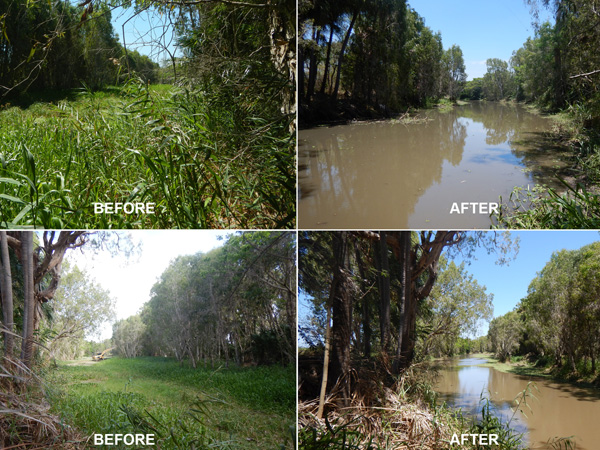Bringing life back to legendary waterhole
By Greening Australia
When Neale Griggs took over property adjacent to the West Haughton River wetlands in Queensland 18 months ago, little did he know that he would soon be playing a role in helping to protect the Great Barrier Reef.
The iconic ‘Crooked Waterhole’ on Neale’s property, once legendary for catches of barramundi, had become densely choked with weeds. When Greening Australia approached him about helping to restore the wetland as part of Reef Aid, a major program to improve water quality on the Great Barrier Reef, he jumped at the opportunity.
“When we purchased the property it was not hard to see that the creek had a problem. Introduced species had taken over and there was very little fish activity or bird life,” says Neale.
Working in partnership with landholders like Neale, Greening Australia is restoring 200 hectares of priority coastal wetlands across two sites, the West Haughton River wetlands and Palm Creek.

Two sites in Crooked Waterhole before intervention (left) showing dense stands of Olive hymenachne and other weed species covering the water, and after intervention (right) with open water.
Coastal wetlands play a vital role in water quality, filtering fine sediment and nutrients from flood waters before they are washed out to the Reef.
“We have selected sites that are interconnected and adjacent to the national park and Ramsar listed wetlands. Most sit on private land and have significant fisheries and biodiversity values. They also form an important buffer between the farmland and the Great Barrier Reef World Heritage Area,” says Jelenko Dragisic, Greening Australia Director of Conservation.
“Neale had done an amazing job clearing the China apple infestation on his property and re-establishing grass cover, but he lacked the equipment, expertise and resources to restore the wetland. We teamed up with Neale to help him return the waterhole to its natural state in a way that complemented his farm management. In three weeks we were able to clear almost three kilometres of channels.”
‘Due to the extremely dense vegetation over the channels we couldn’t use a helicopter to spray the weeds, it was too thick to use a boat, and too dangerous for people to spray by hand. Instead, we used an amphibious excavator which allowed our contractor to do in seven days what would normally take a team months to do.”
Because the weeds were largely floating, the use of the excavator also caused minimal environmental disturbance, including significantly reducing the amount of herbicide needed.
“It was incredible seeing the site after the amphibious machine had finished. It was like keyhole surgery – not a branch was missing!”
“They have done a mighty job at cleaning and restoring the creek back to its natural state. I believe that Greening Australia has made a huge contribution to the environment in our little part of the country. With their help, we intend to keep the creek in pristine condition,” says Neale.
“In the next twelve months, we will see life return to the area. We have already seen birds move back into the estuary. With the wet season flood flows we expect native fish and crustaceans to join them and in the long term, maybe even crocodiles,” says Jelenko.
“Building relationships with landholders is critical to the success of Reef Aid as is the commitment landholders like Neale make to steward the land and ensure that our efforts are not reversed.”
“We’re now waiting for the rains to flush out the channels and return the land to its full natural beauty.”
The site will continue to be monitored to track improvements in fisheries, water quality and vegetation.
The project is supported by the Ian Potter Foundation, Virgin Australia, and the Australian government’s Reef Trust.
Visit www.greeningaustralia.org.au for more information.



